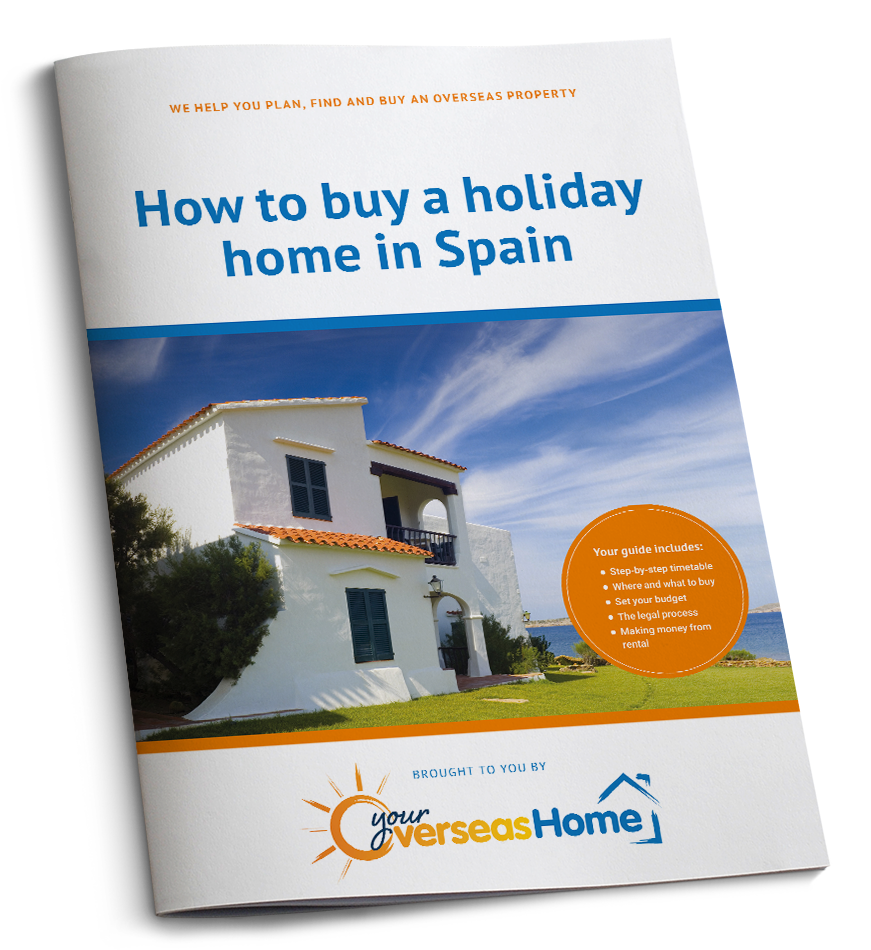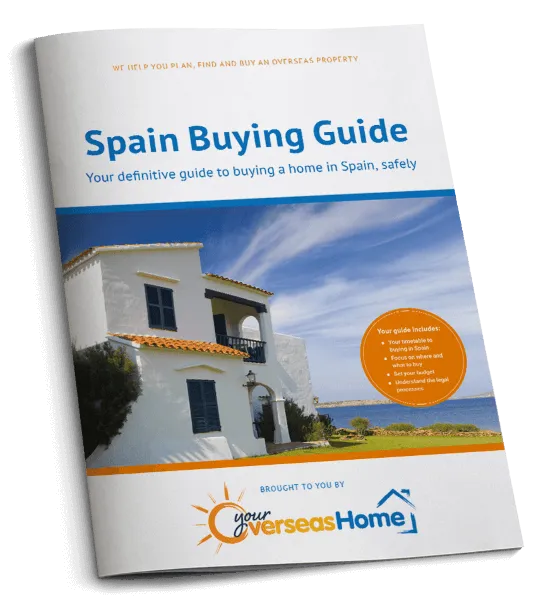Thinking about a move to Mallorca? Spain is awash with amazing costas and sundrenched islands, but for many of us Mallorca shines the brightest of all. What’s so special about it? Where do you start! Here are ten great reasons to move to, or buy a holiday home in, Mallorca.
You can drive from the airport in Palma, the island’s capital, to every corner of Mallorca in little over an hour. It’s just 43 miles across and 62 miles from north to south. Despite its relatively diminutive size, it’s the largest of the Balearic islands, with seven times the population of nearby Ibiza.
Mallorca’s dimensions actually contribute to why it’s such a perfect destination for full-time living. Don’t worry – you still get that distinctive “island life” feel. However the island’s size, coupled with the presence of a large and thriving capital city, mean it’s a place that never feels too isolated.
Mallorca is truly a destination that can mould around any lifestyle. Whether you want sophisticated culture, frenetic partying, boats and marinas, or total isolation, there’s a part of Mallorca that will provide.
This article looks at ten things you absolutely need to know if you’re considering moving to Mallorca. This is an island where there’s plenty to discover – so read on to grab the inside track.
When you do decide to buy in Spain, Smart Currency Exchange is the specialist in exchanging your pounds into euros. They have two offices in Spain too, in the Costa Blanca and Costa del Sol. Read Smart’s Property Buyer’s Guide to Currency here.
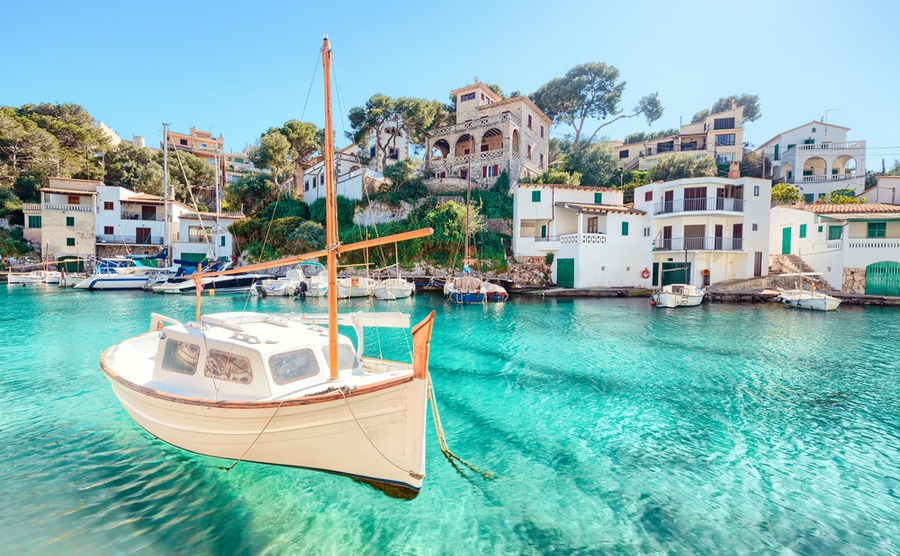
Cala Figuera, south-east Mallorca
Palma: Spain’s coolest capital?
Many tourists to Mallorca never visit Palma. They simply land at the airport, just east of the city, then transfer immediately to a beach resort. However, Palma itself is a large and thriving city, and the capital of all the Balearic islands.
Around 400,000 people live in the city itself, with 550,000 in total in the Palma municipal area. To give you a sense of perspective, Liverpool and Manchester have similar populations. In a reflection of Mallorca’s cosmopolitan nature, over 60,000 of Palma’s residents are non-Spanish.
Palma has a five kilometre seafront boulevard, all the shopping facilities you’d expect from an international city, and plenty of history – think cathedral, castles and palaces. It also excels on all the practicalities, including a thriving transport network (see below) and a world-class airport. Palma airport is the third busiest in Spain, processing tens of millions of passengers every year.
SEARCH for your Mallorquín property
Palma property highlights
For property buyers, there are some city centre possibilities definitely worth focusing on. The cool alleyways on the old town were laid out in the medieval period when the Moors ruled the roost. Behind the gates you’ll catch tantalising glimpses of Moorish “patios”, green oases with water features, around which are attractive townhouses. Many have been turned into boutique hotels while others have million-euro price tags.
One of the most attractive and trendy areas of the city is Santa Catalina, close to the centre but more bohemian than the swish shops of Avenue Jaime III in the very centre. Santa Catalina has vintage shops and cool cafes, but it’s not cheap – nowhere is this close to the centre. But in Mallorca, catching a bus into the centre of the city is easy from just about anywhere. You can even get the wonderful old train to Soller, through the orange groves and the mountains of the north.
Read about buying in the other Balearic islands here.
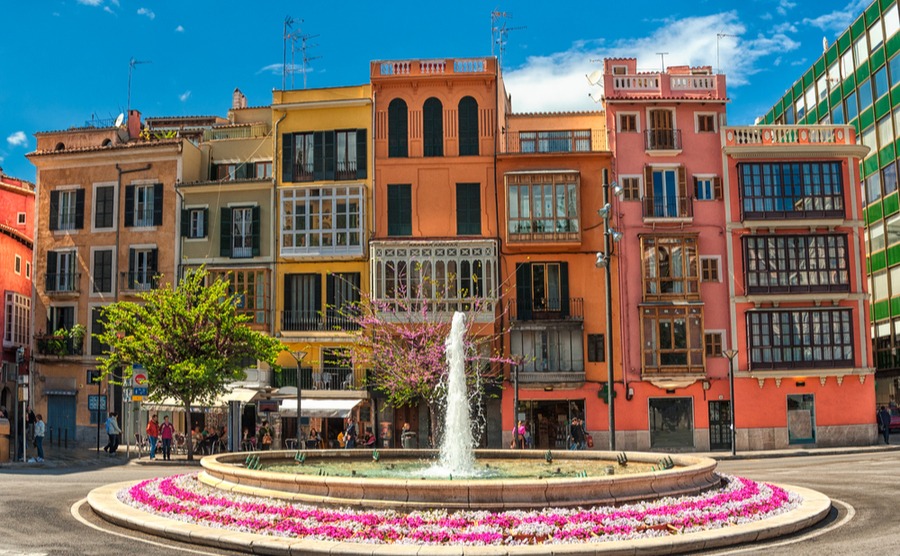
Townhouses in central Palma
Mallorca is a land of micro-climates
As we discuss below, all of Mallorca has an enviable climate. However, those in the know recognise the microclimates across different regions.
Generally speaking, the hottest and driest weather is across the south of the island and in flat central areas. The north can see more cloud, and the Tramuntana mountain range in the north-west usually sees most rain.
These microclimates are interesting to watch. It’s not unusual to be able to look down from a sunny mountain onto rain below, or vice versa. But while these weather anomalies are fun to observe, it’s unlikely they should influence where you live when you’re moving to Mallorca. As a TripAdvisor forum poster said on this subject, if you’re in Mallorca in the summer, “it will be hot!”
Imagine endless good times in your own Mallorcan holiday home! Download your free guide, How to Buy a Holiday Home in Spain.
Wonderful weather, almost all year
Weather in Mallorca isn’t only great in the summer. The climate is mild all year round, and only December, January and February have average daily highs lower than 17 degrees Celsius.
There’s also an average of around 300 days of sunshine each year – a perfect tonic if endless grey days get you down in northern Europe.
Mallorca is a relatively northern island in Mediterranean terms, but in the peak summer season it does get properly hot. In July and August, average daily highs nudge 30 degrees Celsius. Higher temperatures than 30 are far from unusual.
Mallorca is a hit with overseas residents
Mallorca has been a popular destination for international residents for decades, but it’s not overrun. A fifth of the island’s population are from overseas. There are considerable numbers of Italian and German residents, as well as Brits, and a steadily rising number of Scandinavians.
One notable plus of such a diverse population is an established infrastructure of companies dealing specifically with their needs. It’s easy to find specialist legal services and English-speaking medical professionals. Although it’s obviously beneficial (and appreciated) if you can speak Spanish, Mallorca is a place where it is quite easy to get by in other native languages.
Cheap to get to from the UK
Moving to Mallorca is incredibly practical if you want to travel regularly to and from the UK. With a tremendous amount of competition on the routes, it’s far from unusual to find advance return flights for less than £20. This makes remote working with occasional “commutes” very much possible.
It helps that the flight between London and Palma is only around two hours long – sometimes even shorter when there’s a favourable tailwind. It can seem rather surreal to go from Britain’s winter gloom to blazing sunshine and palm trees in less than two hours – but that’s the happy reality.
Easy to get around
If you’re moving to Mallorca, you will quickly discover how easy it is to get around the island. There’s a good road infrastructure and hire cars are both simple to come by and good value.
It’s also far from essential to drive yourself. The island’s taxi network is staggeringly efficient, with cabs often turning up seconds after a call. There are cheap and frequent busses, three train lines, and a small metro system covering the city of Palma. Finally, there’s an historic (and particularly scenic) train line running between Palma and Soller.
City, country or seaside
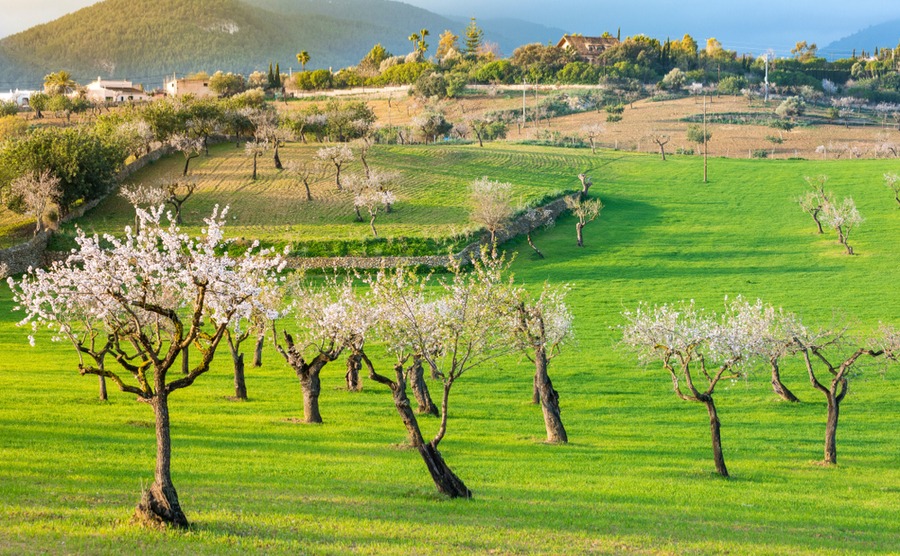
Mallorca’s green interior, one of many great reasons to move here
Moving to Mallorca means having the choice of any lifestyle you want. You can opt for cosmopolitan living in a “city by the sea,” or an isolated rural idyll in the mountains.
While it’s certainly not everybody’s cup of tea, there’s even the option of living right in the middle of a party zone. British youngsters flock to Magaluf every year, and there’s a strongly British feel to neighbouring (but quieter) Palmanova. Half an hour away is Playa de Palma, a huge resort area often described as the German equivalent of Magaluf. While these buzzing resorts don’t appeal to everyone, they’re worth a mention if your plans of moving to Mallorca include thoughts of setting up a business to appeal to tourists.
It’s well worth fully exploring the island, and remembering that there’s much more to Mallorca than the areas either side of Palma airport.
Mallorca, Spain
For example, you may want to check out:
Portals Nous
An upscale area overlooking the luxurious Portals marina, where you’ll find hundreds of multi-million-euro yachts. There’s also all of the boutiques and high-end restaurants you’d expect – to cater for their owners! This is a popular area with international residents, and has a year-round local feel, a million miles away from the atmosphere in nearby resort towns.
Apartments here start at around €250,000, and the sky’s the limit for luxurious hillside villas.
If you’re preparing to come over to Spain to look at properties, make sure you know what to look for by reading our free guide, Your Viewing Trip.
Soller
A strikingly attractive town backed by mountains, Soller has a French feel and lots of choice of property. There are modern apartments in the port area from around €200,000, and town houses packed with character from around €275,000. Check out Deia and Valldemossa too.
Pollensa / Port Pollensa
Another area popular with Brits, Pollensa is on the north of the island. It’s well-populated all year around, but noticeably quieter in the winter – a contrast that can prove strangely appealing. Property here can be cheaper than elsewhere on Mallorca, with apartments from €180,000 and village houses starting at a little more than that. There’s plenty of premium property in this region too: €5million villas abound in the surrounding area!
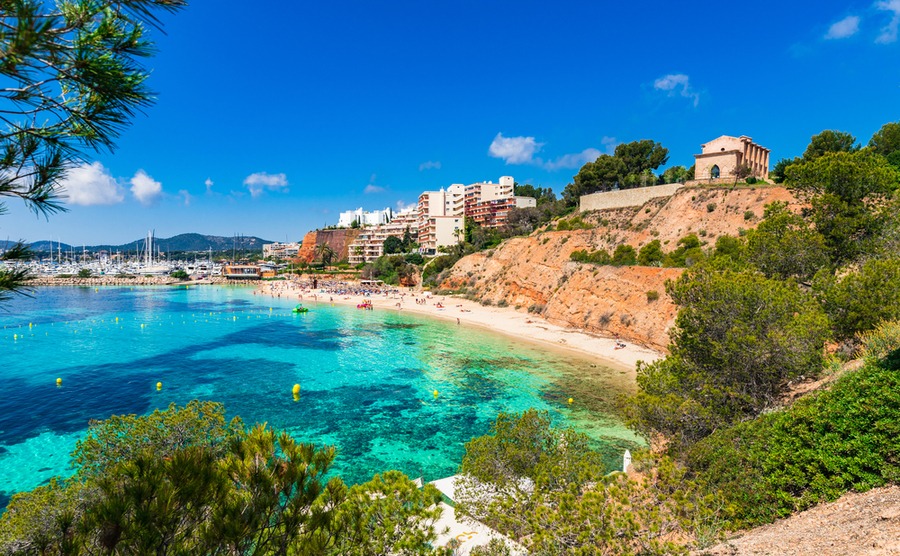
Portals Nous, where royalty meets yachtie
You don’t have to be rich!
We’ve already covered property in Port Pollensa, but there are still other areas of Mallorca where the property is at the more affordable end of the scale.
“Palma Beach” is going through a serious rebrand at the time of writing. A cluster of new five star hotels has opened in recent years, and the authorities are keen to see the area attract a different kind of tourist to those who frequent the beer halls and neon-lit bars.
In this area, you can still pick up “front line” apartments for around €300,000, and they could prove a good investment given the lofty plans for the region. There are cheaper options back from the coast too.
Family buyers on smaller budgets tend to head to the east of the island, passing Manacor, the home town of Rafa Nadal on the way. There are both mega-resorts here and some of the most beautiful seaside villages in the entire Mediterranean, such as Cala Figuera in the south-east.
Mallorca may not be cheap, but learning a few negotiating tricks will prevent you being ripped off abroad. Read our guide, How to Negotiate Abroad.
Every amenity you can imagine
Mallorca is an island specifically designed to provide holiday-makers everything they could wish for. This can work out very well for you if you’re contemplating moving to Mallorca.
There are more than 20 golf courses, theme parks and water parks of all descriptions, and shopping options including designer boutiques, mainstream brands and artisan stores. There’s even a 60 store outlet mall a short distance from Palma.
And don’t, of course, forget the beach life. Beaches in Mallorca range from secluded secret coves to wide open spaces, complete with promenades packed with restaurants and bars. Every water-based activity you can think of is on offer. Best of all, the sea is something you can truly make use of, with the Mediterranean water genuinely warm for swimming in the summer months. It sometimes tops 27 degrees Celsius.
Beware the Airbnb clampdown!
One thing to be aware of if you’re moving to Mallorca is that you may not be able to rent out your home as an Airbnb. There’s been a clampdown on this kind of short-term renting in the capital, Palma, with the government going as far as fining Airbnb for listing unregistered properties.
As things stand, the restrictions include all flats and apartments. Detached houses may be exempt from the Airbnb ban if they meet certain criteria. As such, it’s worth checking the latest news in detail before assuming you can make money from short-term lets. On the bright side, these restrictions are designed to ensure prices don’t spiral out of control for permanent residents.
Moving to Mallorca is a dream for many people in northern Europe, seeking a sunny island life. Hopefully learning these important facts will help you turn that dream into a reality.


